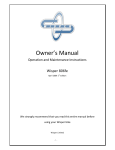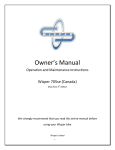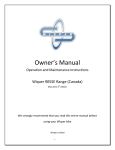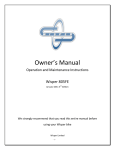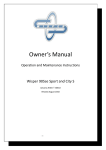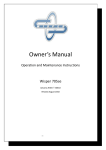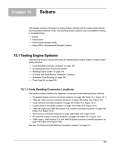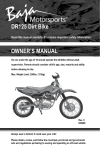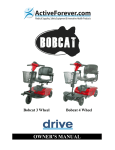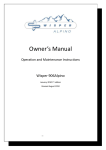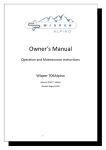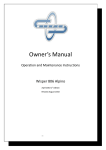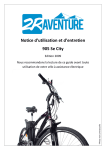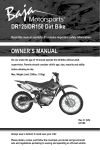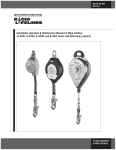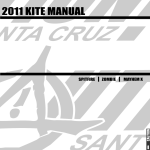Download 905se City Manual
Transcript
Owner’s Manual Operation and Maintenance Instructions Wisper 905se City January 2009 1st edition We strongly recommend that you read this entire manual before using your Wisper bike Wisper Limited -1- 905se City User Guide Introduction Page 3 Part 1 Caring for your Wisper bike and pre use checks 1 2 3 4 5 6 7 8 Before you set off for the first time Before each use Battery care Recharging your battery Water Maintenance and adjustments Technical specifications and performance Simple trouble shooting Part 2 Controls and Equipment 9 10 11 12 13 14 15 16 17 18 19 20 21 Battery on off and battery lock The red button The green button Pedelec mode and High Low button Throttle Brakes Steering stem and handle bar clamp The front connection box Quick release saddle height adjustment Saddle post suspension Rims and spokes Chain and drive wheel Derailleur Page 4 Page 5 Page 5 Page 6 Page 6 Page 6 Page 8 Page 9 Page 9 Page 10 Page 10 Page 11 Page 11 Page 12 Page 13 Page 13 Page 14 Page 14 Page 14 Page 14 Page 14 Warranty Page 17 Getting the best possible range from your Wisper bike Page 18 -2- Introduction Thank you for choosing a Wisper electric bicycle. By making the decision to use an electric bike you are helping to safeguard our environment by saving our planet’s precious resources and reducing carbon pollution. Before you use your Wisper bike it is important that you read this manual carefully. If there is anything you do not understand completely please contact us or your retailer. Please observe traffic regulations, and don’t lend your bicycle to anyone who is unfamiliar with it. The bicycle can only legally be used on the road by a person aged 14 years or older. We strongly advise you to always wear a cycle helmet when using your bicycle and if you are unfamiliar with cycling to attend a cycle proficiency course prior to using it. Your Wisper Works 905Se City is not a toy and should be considered a serious mode of transport. As with all bicycles it is important that you stay within safe limits, if you feel as if you are traveling too quickly for the road conditions you probably are so slow down. Test your brakes prior to using the bike every time you use it and remember the bike will not stop as quickly in wet or icy conditions as it would on a dry road. Frequently check your tyre pressures. They should be 60 psi or 4.1 bar. Low tyre pressures will result in damage to the tyres and will massively reduce your range. Before you use the bike for the first time you must make absolutely certain that it has been correctly built. You can do this by either taking it to your nearest cycle engineer or if you are proficient in cycle mechanics inspecting it yourself. In particular you must make sure that the pedals, saddle, handle bars and any self assembly items have been correctly fitted. NEVER drink alcohol and ride your electric bike. The use of alcohol greatly reduces reflexes and limits your ability to ride safely. Even a very small amount of alcohol will limit your ability to be safe on the road. When you need to replace your battery please either dispose of it properly or preferably send it back to us or your retailer and we will make sure it is properly recycled. Happy cycling! Wisper Ltd -3- Part 1 Caring for your Wisper bike and checks Although your Wisper bike has been thoroughly tested prior to delivery, it is very important that you check the bike thoroughly before its first use. Equally important are frequent and regular spot checks they will protect you and your Wisper bike. Please read this manual carefully. Only on full understanding of all the functions of this electric bicycle should you attempt to use it. Your Wisper bike has been transported in a strong twin walled carton, to save space it has been delivered with the front wheel, handlebars, seat post and seat, rear rack* and pedals ready for assembly with the tool kit provided**. * Rack not supplied on all models ** Your retailer may have assembled your bike for you if not you will find fitting instructions on the Wisper website www.wisperbikes.com 1 Before you set off for the first time 1.1 1.2 1.3 1.4 1.5 1.6 1.7 1.8 Check the handle bars and handle bar stem are properly tightened. Check all other nuts and bolts and fixings are properly tightened, pay particular attention to the motor fixings, side kick stand, yoke and steering head bearings. Check brakes and brake isolators are functioning properly. Check tyre pressures are 60psi / 4.1bar and tyres are not damaged. Check reflectors and lights are functioning properly. Make sure battery is fully charged. Load battery into bicycle and turn on with key. Check the power indicator lamps are illuminated on the right hand side of the handle bars if they do not illuminate press the red on / off switch once. -4- 1.9 1.10 2 To avoid dangerous unplanned acceleration, always make sure that the electrical system is turned off and the power indicator lamps are not illuminated when mounting, dismounting or leaving the bike unattended. For your safety, please turn off the power key on the battery when stopped or walking the bike. Remember to validate your warranty by visiting www.wisperbikes.com/mywarranty and filling in your details. Before each use It is important you perform a quick check of your bike every time you use it, checks should include the following, if you find any damage or problems do not use the bike until the problem has been solved or you have had the faulty item checked by a bike mechanic or your retailer. 2.1 2.2 2.3 2.4 2.5 2.6 2.7 Check tyres for any visible damage Check tyre pressures (60psi / 4.1bar) Check for any lose nuts bolts or fixings Check brake functions Check electronic functions Check reflectors are in place and lights are working Check your battery for any visible signs of damage 3 Battery care 3.1 Before you use the battery for the first time it is best to give it a full deep charge for 12 hours. To fully condition your new battery give it complete deep charge, discharge cycles for the first three charges. This is achieved by charging your battery for 12 hours and then using the bike until the battery is completely drained. After this “conditioning” process you can then charge and discharge the battery as and when you require for long or short periods. If you are going to leave your battery uncharged for more than eight weeks it is best left half charged. You should then re charge it every four weeks for two hours to keep it in top condition. Before setting off on any journey it is always better to have a fully charged battery. Always remember that you use up to three times more power when setting off under the twist throttle. To preserve the life of each charge always set off using pedal assist. Do not expose the bicycle or battery pack to fire, heat sources, acid or alkaline substances. 3.2 3.3 3.4 3.5 -5- 3.6 3.7 3.8 3.9 When leaving your bicycle during hot weather always leave in a shaded well ventilated area For best results always recharge the battery at room temperature Before unloading the battery make sure it is turned off at the key, then raise the saddle and unload the battery using its handle If your battery is damaged or appears to be overheating for any reason immediately return it to your retailer for advice and a safety check 4 Recharging your battery 4.1 4.2 4.3 First make sure the charger is turned off, connect the output connector plug from the charger to the battery, connect the charger to the mains and turn on the mains power. Turn on the charger. The red and yellow lamps on the charger indicate the battery is charging, when the yellow light turns green the battery fully charged. Always turn off the charger and disconnect from the mains after charging. Always disconnect the charger from the mains before disconnecting the charger from the battery. It is possible that the battery will take up to 12 hours to charge on the first three charges. When charging the battery always do so in a dry and well ventilated area. Do not leave the charger connected to the mains when not in use. 5 Water 5.1 5.2 Your electric bicycle is rain and splash proof and can be used in all weathers. The electrical components of the vehicle, such as motor, battery, and controller, must not be submerged in water. 6 Maintenance and adjustments 6.1 IMPORTANT! Do not attempt to open the casings of the battery, motor or controller it could be dangerous and all warranties will become void. If you experience a problem contact our service department or your retailer. Wheel spokes should be adjusted after 300 miles riding. Handlebar and saddle tubes should never be raised beyond the maximum indicated by a safety line around the tubes. 6.2 6.3 -6- 6.4 Torque recommendations Front axle nuts 46N.m Back axle nuts 70N.m Handlebar clamp Refer to illustration 15.1 Bolt 1 16N.m Bolt 2 10N.m Handlebar stem expander bolt 18-20N.m Seat pillar clamp nut/bolt 5-8N.m Brake cable anchor bolt 5N.m Brake centre bolt M6: 11N.m Seat clamp nuts 24N.m Cotter pin nuts R: 42N.m L: 46N.m Gear shifter nuts 4N.m V brake caliper nuts 10N.m Rear carrier nuts 8N.m Mudguard bracket nuts 8N.m Other nuts torque depends on the size 6.5 6.6 6.7 6.8 M4 2.5-4N.m M5 4-6N.m M6 6-7.5N.m Your bike has a rear derailleur that will automatically tension your chain. However if the chain becomes loose or frequently comes off the front cog, you can easily adjust the chain tension by loosening the rear axle nuts slightly, and adjusting the tension bolts. Make sure that the chain runs freely and re tighten the axle nuts. The brake leavers should lock the wheels when compressed half way between their open position and touching the handle bars. When they need adjusting please follow the instructions on our web site www.wisperbikes.com Electric Bikes, Manuals. Warning Handlebar hand grips or tube end plugs should be replaced if damaged, as bare tube ends have been known to cause injury. Warning If replacing forks they must have the same rake and same tube inner diameter as the originally fitted to the bicycle. IMPORTANT braking distances increase on wet or icy roads. -7- 6.10 Regularly lubricate the gears and chain with light oil and the brake bushes (not the rubber brake shoes or disc) with a little grease. 6.11 Recommended tools for proper maintenance Torque wrench with N.m gradations 2, 4, 5, 6, 8 mm Allen wrenches (keys) 9, 10, 15 mm open-end wrenches 15 mm box end wrench Socket wrench, 14, 15, and 19 mm socket T25 Torque wrench No. 1 Phillips head screwdriver Bicycle tube patch kit Tyre pump 7 Technical specifications & performance Type Performance Assisted range Maximum speed Weight with battery Maximum load Wisper Works 905se City (with 75kg 165lb rider) 8A up to 65km (39 miles) 14A up to 110km (66 miles) 8a up to 42km (25 miles) 14A up to 70km (42 miles) 25kph (15.5mph) 23.6kg max 130kg (240kg) Battery specifications Cell Type Capacity Rated voltage Advanced Environmental Lithium Polymer with BMS 8Ah or 14Ah 37V Battery only Main Controller specifications Low voltage safeguard 31.5V Overload current safeguard 15A Main hub motor specifications Motor type Hi speed brushless Rated power Aus NZ 200W / Europe 250W / USA Canada 350W Rated voltage 36V Charger Lithium 115 to 230V 36V fan cooled -8- 8 Simple Trouble shooting Problem Possible reasons Trouble shooting Top speed too slow 1. Low battery voltage 2. Handle bar control problem 3. Damage to motor driveline 1. Recharge battery fully 2. Call service 3. Call service Power on but motor not working 1. Battery not connected position 2. Fused 3. Motor connection damaged 4. Handle bar control problem 1. Re install battery 2. Replace fuse 3. Call service 4. Call service Driving shorter distance per recharge 1. Tyre pressure too low 2. Undercharge or charger fault 1. Check pressures 2. Recharge completely or have charger inspected 3. Replace battery 3. Battery capacity loss or damage 4. Hill climbing, frequent stops, strong head winds, over loading 4. Use power assist and try and avoid throttle only Part 2 Controls and Equipment In this section we will describe the functions and any specific maintenance needed on all the main controls and ancillary equipment. 9 Battery on off and battery lock 9.1 Your Wisper bike has 1 set of 2 keys. The key for turns the battery on/off and locks the battery in the bike. Please keep a careful note of the key numbers as we cannot replace them without these numbers should they become mislaid. On bikes built after April 2009 the battery is connected to the electrical system of the bike automatically when you slide the battery into the frame. Pre April 2009 bikes need to be connected via a cable that plugs into the side of the battery. To turn on the bikes electrical system, turn the key in the battery clockwise, to turn off the power turn the key anti clockwise. 9.2 -9- 9.3 9.4 9.5 9.6 9.7 When the battery key has been turned to the on position the bike is ready for use. The red button on the handle bar isolates the power from the bike, when the bike is “on” you will see the battery power lights illuminate above the red button. When the bike is “off the lights are not illuminated. When the bike is “off” you will not get any assistance from the battery and motor and the bike is effectively an unpowered push bike. Press the red button to toggle between “on” and “off” To lock the battery into the bike frame turn the key clockwise to unlock turn the key anti clockwise. Read 3 and 4 for battery care and advice on charging at the beginning of this manual. The battery can be charged either on or off the bike. To remove the battery turn off the power by turning the key to position “OFF”, If your battery has a socket in its side (pre April 2009) disconnect the plug and socket. If your bike is fitted with a connector at its base (after April 2009) this is not necessary. Remove the seat post. Using the handle on top of the battery lift the battery out. To replace the battery reverse the procedure for removing it. On the handle bars 10 The red button 10.1 When the red button is pushed and the lights go out you have turned the bike “off”. When the bike is “off” you will not get any assistance from the battery and motor and the bike is effectively simply an unpowered push bike. To turn the power back on so the pedelec and throttle work again simply press the red button once, the lights will illuminate above the red button showing the power is on. 11 The green button (not USA, Canada and some European countries) 11.1 The green button (when fitted) can be found on the left hand side of the handle bars. The green button delimits the motor power and lets the rider ride the bike above 25kph (15mph) with assistance from the motor to about 30kph (19mph). The green button should only be used on private land and never on the public highway. IMPORTANT WARNING The use of the green button on the public highway in many countries turns the bike into a moped and any rider operating the green button on the public highway would render themselves open to prosecution, fines, penalty points and loss of driving license. It is important that you verify the legality of the green button in your region, if it is not legal do not use the bike and we will remove it for you free of charge. - 10 - 12 Pedelec mode and High Low box 12.1 When you first ride your Wisper bike you will notice that after one turn of the pedals the motor will start working assisting you to ride the bike by adding power through the rear wheel. This is the standard or pedelec mode, to continue using the pedelec mode you must keep turning the pedals, if you stop the motor will stop and the bike will slow to a halt. If you start pedaling again after one turn of the pedals the motor will start again. You will find a small black box on the handle bars with High and Low printed below two green LEDs (small lights). When the Low button is pressed and the LED above illuminates the assistance power in pedelec mode is 40% of the maximum power available from the motor. When the High button is pressed and the LED above illuminates the assistance power in pedelec mode is 80% of the maximum. High mode is generally used when you need the maximum amount of assistance from the motor. Low mode is used when you do not need the instant assistance power of 80%. Low mode is used in high traffic situations or poor conditions such as ice and snow when 80% of full power could be dangerous. 12.2 12.3 13 Throttle 13.1 The throttle can be used in some countries such as the UK, Australia, New Zealand USA, and Canada independently to the pedelec mode. Check with your supplier if it is legal in your region. Bikes are usually set up to be legal in the region in which they are supplied. The independent use of the throttle, when available, will enable you to use the throttle without pedaling. The use of the throttle in pedelec mode is legal in most countries. Use of the throttle in pedelec mode enables you to turn up the power to the motor as long as you are pedaling the bike, if you stop pedaling the motor will stop too. If you have the pedelec mode set to Low, you can increase the assistance from the motor from 40% to 100% of available power simply but turning the throttle towards you. This also works in High mode and will let you increase the power from 80% to 100% of available power. 13.2 13.3 IMPORTANT Make sure your throttle grip and the grip on the left hand side of your handle bars are always intact, in good condition and on the bike. Uncovered handlebar tubes can be very dangerous in case of a collision. - 11 - 14 Brakes 14.1 14.2 Front: V brake Rear: V brake The brakes on your Wisper bike are fitted with cut outs which are required by law. This means that when you pull on either the back or front brake lever the motor immediately stops working. How to adjust and maintain your brakes Once a month, inspect brake pads for wear. If the grooves in the braking surface are less than 2 mm deep replace the pads. Replace disc brake pads that are thinner than 1.0 mm. To replace V brake pads 14.3.1. Use 5mm Allen key to loosen bolt A and take the cable out. Use 5mm Allen key to undo bolt C on the right & left, and remove the spacers and washers. 14.3.2. Install new brake pads, then with both pads pressed against the wheel rim, ensure that distance B (in the diagram) does not exceed 65mm. To decrease distance-B, exchange wide & narrow spacers on each brake pad. Before finally tightening brake pads, make sure they are aligned correctly on the rim, and there is a gap of 1mm between the top of the rim and the top of the pad. Hold each pad against the rim (one at a time) & tighten bolt C. Finally tightening them to 6-8N.m 14.3.3. Insert cable back into bolt A, slot cable guide pipe into holder and fit protector over guide pipe end. Set cable in bolt A so that the combined pad/rim clearance (the gaps from left pad to left rim surface and from right pad to right rim surface) is 2mm, then tighten bolt A. Finally tightening it to 6-8N.M. Balance brake arms with screw D. Depress brake lever a few times while Checking to see that tension is equal for both arms. Pad/rim contact should occur at the same time each side. Clearance should be 1mm each side. 14.3.4. Adjust pads so they are properly aligned (see step 2), as tension adjustment will probably have altered original pad alignment. 14.3 Warning: If you are unsure about any part of the installation process you should seek advice from Wisper service center or qualified mechanic. - 12 - 15 Stem handle bar clamp 15.1 Your bike has been fitted with a quick release handlebar clamp that allows you to change the position of the bars quickly and easily to find the most comfortable riding position. The stem and handle bars need to be fitted before you use the bike. To fit, insert the stem into the front tube at least to the position of the “Minimum insertion” mark. Tighten the quill bolt and fix stem. Push in the direction of the arrow slide cap 1 and lift lever 2. Adjust stem to preferred angle and lightly tighten BOLT 1 then turn BOLT 2 to suitable position so that the slide cap 1 will fit when locked, then press down lever 2 to lock the handle bars in position. Test the bars to make certain they are tight and do not rotate. If they are not tight enough, lift lever 2, adjust BOLT 2 again then press down lever 2. Repeat until the handle bars are tight and safe. 15.2 15.3 15.4 14.5 15.6 15.7 IMPORTANT when fitting always lock Bolt 1 first so the body and first cap touch then lock Bolt 2. 15.8 When adjusting stem angle, it is not necessary to adjust bolts. 16 The front connection box 16.1 The front connection box allows for the easy removal for repair or replacement of any of the electronic components on the handle bars. - 13 - 17 Quick release saddle height adjustment 17.1 Your Wisper bike has been fitted with a quick release saddle post collar to facilitate the movement of the saddle to remove the battery or to change the riding position. It is important that the nut on the collar is tightened so the post will move in the bike tube firmly. Make this adjustment with the quick release lever in the open position. Adjust the seat to the correct height and close the lever. When you sit on the saddle there should be no vertical movement at all in the saddle post. 17.2 17.3 18 Saddle post suspension 18.1 For your comfort your bike has been fitted with saddle post suspension it has been set for a person weighing 75kg. If you are lighter than this you may not feel any benefit and if you are heavier you may feel the suspension bottoming out. The suspension post can be adjusted by removing the whole post with saddle attached from the bike. On the bottom of the post you will find an alan key adjuster simply turn it clockwise to tension the spring for heavier people and anticlockwise to release tension for lighter people. 18.2 IMPORTANT never raise the saddle past the point where the maximum marks on the saddle post are visible above the quick release collar 19 Rims and spokes 19.1 It is essential to get your spokes checked and tightened after 300 miles. This is a free service provided by your supplier. If this service has not been undertaken at the correct time this may cause damage to the wheels and spokes that will not covered under our guarantee. 20 Chain and drive wheel 20.1 20.2 20.2 The chain and drive wheel are made from rust proof materials. Lightly oil with bicycle chain oil the chain at least once a month. Because your bike has a rear derailleur the chain will be automatically adjusted. 21 Derailleur maintenance and adjustment 21.1 Required Tools You’ll need a dry cloth, a Phillips screwdriver, a 5mm Allen wrench, and a light lubricant. - 14 - 21.2 Rear Derailleur 21.3 How derailleur work Almost all modern derailleur function the same basic way. They are designed to move (or derail) the chain from one sprocket to the next. The upper guide pulley (or jockey pulley) moves the chain in both directions. For instance, when you want to climb a hill, you shift down to a lower gear. This pulls the shift cable and forces the guide pulley to change to a bigger sprocket. When you want to go faster, you adjust the shifter to a higher gear. This releases shift cable tension and allows the derailleur springs to pull the guide pulley back down to a smaller gear. Each time you shift gears, the length of chain changes. The lower tension pulley is spring-loaded to take up this slack. Adjustment screws There are 3 adjustment screws - the B-Screw (B-tension adjustment), the H-Screw (high gear limit stop) and the L-Screw (low gear limit stop). Adjustments on these screws should always be made in 1/4 turn increments. B-Tension Adjustment The B-Screw controls the derailleur body’s angle in relation to the sprocket-set. Shift down to the largest sprocket and check the distance between the guide pulley and the large sprocket. If the guide pulley is rubbing on the sprocket, tighten the B-screw clockwise to increase tension and move the pulley away from the sprocket. If there is a large gap between the pulley and sprocket, loosen the B-screw until the pulley rubs the sprocket, and then tighten it until it just clears. 21.4 21.5 - 15 - 21.6 21.7 21.8 21.9 21.10 High Gear Limit Stop The H-Limit screw high gear limit stop prevents the guide pulley from shifting any further past the highest gear and into the axle. In order to adjust it properly there must be no tension on the lower inner cable. If you feel tension, loosen the cable adjuster until there is none. Now check from behind how the chain is riding on the smallest sprocket. If it looks like it wants ride off into the axle, tighten the H-screw clockwise until it lines up. If it looks like it is rubbing on the next gear, loosen the screw until the chain is nicely centered on the sprocket. Now re-adjust the cable tension until the derailleur shifts smoothly down to the next gear. Low Gear Limit Stop The L-Limit screw prevents the guide pulley from shifting any further past the lowest gear and into the wheel spokes. Shift down to the lowest gear, step behind the bike, and check how the chain rides on the sprocket. If it looks like it wants to ride into the spokes, tighten the L-screw clockwise until it is centered on the sprocket. If it looks like it wants to shift down, loosen the screw until it lines up. As an extra precaution you can use your thumb to gently push the derailleur body and make sure the chain will not run into the spokes, as this could obviously have a nasty effect on both you and your bike. Cable Adjustment The cable tension adjuster defines how far up or down the derailleur moves. Step back so you can see the chain and sprocket alignment, and then through the gears in both directions, first shifting up two and down one, and then down two and up one. The chain should look centered on each sprocket. If it is rubbing on a larger gear it means there is too much tension on the cable. Loosen the tension by turning the adjuster clockwise. If it wants to jump down to a smaller gear it needs more tension. Increase the tension by turning the adjuster counter-clockwise. Adjusting by ear You can also use sound to check the adjustment. There is always a base-level of noise that can be heard in every gear. This noise will increase in a slightly different way depending on which way the tension is out of adjustment. If there is too much tension you will hear a metallic rubbing sound, but if there is too little tension you will hear a clicking noise as the chain tries to jump to a smaller sprocket. There is usually a cable tension adjuster on your shift lever. With practice you will be able to make small cable tension adjustments while you are riding. Lubrication Now that the derailleur is adjusted, always apply a drop of lubrication to the derailleur’s many moving parts. This will help prevent wear from dirt and rust, and it will keep your gears shifting smoothly. Wipe away any excess lube and take your bike for a test ride to make sure all the gears are working smoothly. - 16 - Warranty Repair or replacement of components IMPORTANT To validate this Warranty the retail customer must register the bike at www.wisperbikes/mywarranty within 14 days of purchase. Only use this product in accordance with this user manual. We offer a limited warranty of on the following items. 1 The main frame Six years 2 Gears, hub motor, bearings, front forks Two years 3 Paintwork (excluding deliberate or accidental damage) Two years 4 Controller and Charger Two years 5 Battery casing, battery leak, battery capacity step-down more than 30% Two years 6 Handle bar controls, brakes (excluding brake shoes and pads) One year 7 Front and rear axle, flywheel or chain wheel One year 8 Electro plating, on wheel rims, rack and kickstand Six months 9 Other cases that render the bike unsafe to use. By negotiation 1. If the product has a quality fault within 15 days of delivery the part will be repaired or replaced or in exceptional circumstances we may replace the whole vehicle. 2. The period of assurance shall commence from the day delivery was made to the retail customer, or from the day the retail customer collected the bike from the retailer. 3. To validate this Warranty the retail customer must register his / her bike at www.wisperbikes/mywarranty within 14 days of purchase. Exceptions to Limited Warranties 1. Damage resulting from misuse, not maintaining the vehicle or not following the guidelines within this user guide 2. Accidental or deliberate damage 3. Damage due to private repair or alteration by user or unauthorised service centre. 4. Failure to produce invoice or proof of purchase. 5. Spare parts and components worn in normal use. 6. Failure to register your bike at www.wisperbikes/mywarranty within 14 days of purchase. - 17 - It is essential to get your spokes checked and tightened after 300 miles. This is a free service provided by your supplier. If this service has not been undertaken at the correct time this may cause damage to the wheels and spokes that will not be covered under our guarantee. Getting the best range from your electric bike. The range you can achieve from your Wisper electric bike can be reduced dramatically for some very simple reasons. Im good conditions you should be able to achieve the following ranges from your bike when using pedal assist. 14A battery 66 miles (110km) 8A battery 39 miles (65km) To make sure you optimise your range please follow the guidelines set out below. 1 When using full throttle from stationary, your 250W motor will draw about 550W. Consider that when cruising along at 15mph / 25kph, with mild pedalling, you only draw about 150W hence, using pedal assist instead of full throttle from stationary saves a good amount of power and will increase your range. 2 Check your tyre pressures. The rolling resistance on the road is at is least when the tyres are at the correct pressure 60psi or 4.1bar. Half flat tyres can half your range! 3 Air resistance is important if you are wearing big baggy clothes in the winter expect lower range than in the summer when your clothing is less air resistant. Also remember that panniers and bags on the handle bars reduce range. 4 Weight affects the range considerably. If you are carrying extra weight in your panniers or towing you range will effected. 5 Battery temperature will make a serious difference in achievable range. It is best to charge your battery at room temperature keep it indoors before you start your journey with the maximum range available by loading a warm battery. There are of course other factors such as bike maintenance, terrain, road conditions and weather but if you keep the five points mentioned above in mind you will find your range is massively improved. Copyright January 2009 Wisper Ltd - 18 -


















